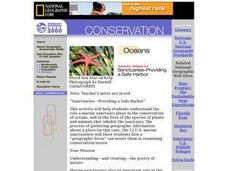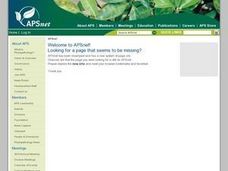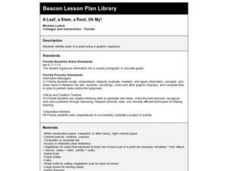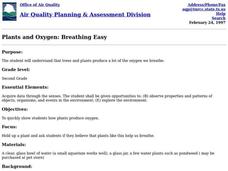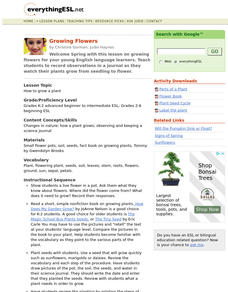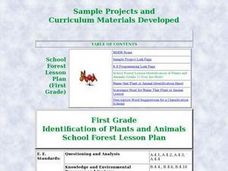Curated OER
Plants from Trash
Students observe how plants recycle themselves, and discuss different types of propagation.
Curated OER
Celery Stalkers
Students participate in a hands-on activity to see how plants take up water and dissolved pollutants.
Curated OER
Sanctuaries-Providing a Safe Harbor
Students investigate the role of marine sanctuaries in the conservation of oceans and the lives of plant and animal species that live there. They write poetry to exhibit what they learn.
Curated OER
How Does a Green Plant Grow?
Students examine how a seed grows, and design an experiment to explore this concept. They make predictions, conduct the experiment, record the results, and interpret the results.
Curated OER
Natural Dyeing with Plants - Scientific Method
Students study the components of scientific investigation by planning and carrying out an experiment in natural dyeing, seeing if different kinds of metal dye pots affect the color one gets from the same plant material.
Curated OER
Down to the Root of the Plant
Second graders identify types of roots and their purposes and observe and document root growth. students observe their roots once a week and measure them to see if there has been any change. Each student keeps a written log of the...
Curated OER
Plant Parts and Their Diseases
Students see how certain plants are very important to us. They explain that healthy plants are important to keep people healthy. They study the major parts of a plant (root, stems, leaves, flowers, fruit and seeds) and their basic...
Curated OER
A Leaf, a Stem, a Root, Oh My!
Students conduct Internet research on plants and complete a WebQuest on vegetable plants. They use a graphic organizer to display their findings, observe actual vegetables and design a salad, noting which part of each plant is included.
Alabama Learning Exchange
Why Roots, Stems, and Leaves are Important
Young scholars use the Internet to research the importance of leaves, stems and roots to plants. They participate in a hands-on experiment to identify the functions of different plant parts.
Curated OER
Adopt A Tree
Students list characteristics that make some plants "trees," identify parts of the tree and their basic functions, describe how trees grow, and recognize products we get from trees and the environmental importance of trees.
Curated OER
Plants and Animals in the Local Environment
Students recognize the different types of plants and animals living in a local environment. They determine how they require different habitats to live, and relate simple life processes to plants and animals found in local environments.
Curated OER
Crops 2: What Plants Need to Grow
Students explore the kinds of things that plants need to grow well.
Curated OER
Edible Plants
Students determine what part of a plant they are eating when they eat different fruits and vegetables.
Curated OER
A Cell Is Like A City
Students create analogies that help them remember the cell parts as well as their respective functions.
Curated OER
Parts of a Plant Lesson
Students, after reading about the parts of a plant, identify each part and describe its function.
Curated OER
Botanical Gardens Lesson Plan
Students define botanical gardens and explain why they are important. They describe a plant using scientific ways.
Curated OER
Weathering and Erosion Splashdown
Fourth graders investigate how plants and their roots help slow the erosion process.
Curated OER
Investigation 7 - Plants In Soil
Fourth graders explain how the components of soil effect plant growth. They brainstorm different kinds of materials that plants could use for structural support. They design an experiment to show that plants can grow without soil.
Curated OER
Growing Flowers
Students grow flowers from seeds. They plant quick-growing seeds in a flower pot and consider what a seed needs to grow. They observe and record the growth of the planted seeds in science journals.
Curated OER
TRANSPIRATION IN PLANTS
Young scholars define the hydrologic cycle, define transpiration, name the three parts of the hydrologic cycle, and record the amount of moisture given off by several green plants.
Curated OER
Identification of Plants and Animals
First graders identify a variety of plants and animals that can be found in the school forest, then differentiate between plants and animals. They find examples of characteristics used to differentiate between plants or animals.
Curated OER
Using Sterile Techniques as a Tool in Studying Plant Diseases
Seventh graders examine the concept of sterile techniques. They realize that plant diseases can be identified and classified in various way. Students identify some of the diseases that attack the garden plants.




